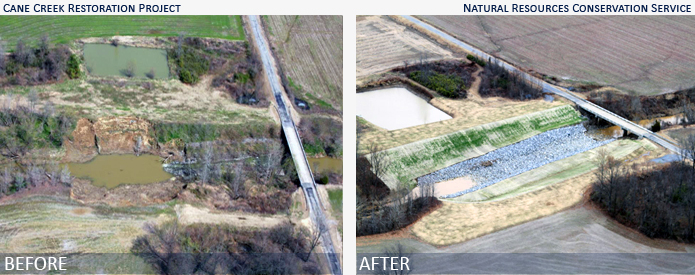Recovery Act, NRCS Help Tennessee Town Fight Erosion

By Michelle Banks
Steve Koonce, a Civil Engineering Technician with USDA’s Natural Resources Conservation Service, remembers swimming in Tennessee’s Cane Creek as a youngster, when he and friends would jump from a bridge into the water 15 feet below. But today, because of a catastrophic erosion problem, that recreation would be a lot more dangerous.
“Today if you jumped off the same bridge, you would need a parachute,” says the Lauderdale County native.
Erosion along Cane Creek, in the southwestern corner of the state near Memphis, has led to the loss of tons of healthy soil and farmland and the crippling of bridges due to unstable stream banks. It’s a problem the state and federal government have been trying to solve since the 1970s. And just recently, the largest stream watershed stabilization project in U.S. history has helped fortify its banks as part of a $14 million effort of the American Recovery and Reinvestment Act of 2009, or the Recovery Act.
The work aimed to protect valuable farmland and protect the residents of Ripley, where rainstorms caused bridges to fail and significant amounts of soil to wash away.
The Cane Creek Watershed District secured and administered funding through the Recovery Act to repair several degraded bridges, address massive erosion and flooding on prime farmland adjacent to the steam, and prevent flooding to nearby homes and businesses. The three-year, nine-month project was completed in October of 2012.
As a result, more than 1,000 acres of prime farmland soils have been protected from erosion. Six public bridges were preserved and a stimulus of $100 million invested in the local economy.
NRCS provided technical guidance and additional financial assistance to help farmers create and implement conservation plans to fully address all resource concerns on a farm. Conservation practices such as erosion control structures, like dams and diversions that control the changes in water elevation, were constructed throughout the watershed.
Farmers with property near Cane Creek can also now prosper since valuable soil and seeds will no longer be washed away with each rain event. By slowing down the sediment disposition into the Mississippi, NRCS prevented hundreds of thousands of tons of eroded soil and sediment deposited downstream each year.
“Without this help, my crop field would have been washed away,” says farmer and life-long local resident George Meadows. “At least 75 acres were consumed with gullies.” Separate from the Recovery Act funding, NRCS implemented 128 erosion control structures like the one on Meadows’ farm.
This project didn’t just protect the river and those who live along it—it also infused money and jobs into the area.
“Almost every person that worked on the Cane Creek project slept in the local hotel, ate at the local restaurants, washed clothes at the local laundry mat and gassed their truck up at the local gas station,” Natural Resources Conservation Service District Conservationist Curt McDaniel says. “All that really makes a difference in a small town like Ripley, home to 27,101 residents. The local hotel owner said he had his best year last year.”
NRCS State Conservationist Kevin Brown added: “A tremendous amount of good was accomplished for the community: jobs were created, the rural economy was stimulated, bridges were saved, partnerships were strengthened, and the environment was improved.”
Partnerships between the landowners, local, state and federal agencies, environmental agencies and conservation-focused organizations paved the way to success. McDaniel says the agency worked with more than 100 landowners and the “list of partnering organizations seems miles long.” Partnerships were the key to the project’s success, he says.
 |
Recovery Act funding saved this bridge, the only direct thoroughfare, just outside the town of Ripley, Tenn.
|
Critically damaged pillings from the erosion of past flooding events nearly crippled the mobility of residents in the Cane Creek watershed.
 |
|
NRCS offered technical guidance for not only the stabilization of the creek bank and erosion control, but the types of vegetation best suited for western Tennessee soils. |